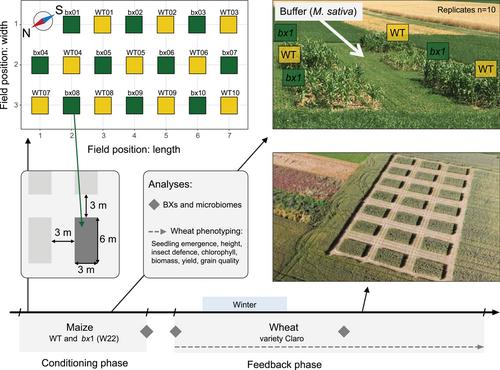Harnessing positive plant–soil feedbacks via crop rotations is a promising strategy for sustainable agriculture. These feedbacks are often context-dependent, and how soil heterogeneity explains this variation is unknown. Plants influence soil properties, including microbes, by exuding specialized metabolites. Benzoxazinoids, specialized metabolites released by cereals such as wheat and maize, can alter rhizosphere microbiota and performance of plants subsequently growing in the exposed soils and are thus an excellent model to study agriculturally relevant plant–soil feedbacks.
To understand local variation in soil properties on benzoxazinoid-mediated plant–soil feedbacks, we conditioned plots with wild-type maize and benzoxazinoid-deficient bx1 mutants in a grid pattern across a field, and we then grew winter wheat in the following season. We determined accumulation of benzoxazinoids, root-associated microbial communities, abiotic soil properties and wheat performance in each plot and then assessed their associations.
We detected a marked gradient in soil chemistry and microbiota across the field. This gradient resulted in significant differences in benzoxazinoid accumulation, which were explained by differential benzoxazinoid degradation rather than exudation. Benzoxazinoid exudation modulated microbial diversity in root and rhizospheres during maize growth, but not during subsequent wheat growth, while the chemical fingerprint of benzoxazinoids persisted. Averaged across the field, we did not detect feedbacks on wheat performance and defence, apart from a transient decrease in biomass during vegetative growth. Closer analysis, however, revealed significant feedbacks along the chemical and microbial gradient of the field, with effects gradually changing from negative to positive along the gradient.
Overall, this study revealed that plant–soil feedbacks differ in strength and direction within a field and that this variation can be explained by standing chemical and microbial gradients. Understanding within-field soil heterogeneity is crucial for the future exploitation of plant–soil feedbacks in sustainable precision agriculture.


